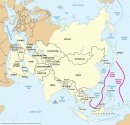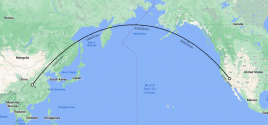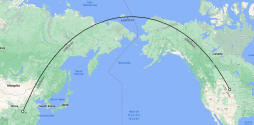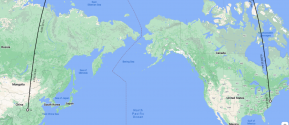And then it turns out this entire time the H-20 is a massive stealthy ground effect aircraft that can easily cross the Pacific while hauling 20+ cruise missiles.
I kid, of course.
I kid, of course.
I think carry 8 YJ-12 should be a minimum.
Doing so would require every single H-20 to be fitted with the probe-and-drogue system onboard in order to refuel other H-20s, which would add additional weight and complexity to every H-20s, on top of the paylaods and initial fuel carried onboard.You would use the fuel tanks in place of the payload for H-20s configured for the tanker role.
Otherwise, you would not use any fuel tanks and the H-20 would be able to carry their regular payload.
Seems more cost effective than creating an entirely different variant that could only serve in the tanker role.
I think carry 8 YJ-12 should be a minimum.
The YJ-12 is a massive missile both in terms of weight and in terms of volume, even if it were in a folded wing configuration.
That isn't going to happen. And to be honest I would be surprised if H-20 is intended to carry YJ-12 internally to begin with.
YJ-12 is a fine and capable missile right now, but it should be superseded by other systems that are a bit more optimized and a bit more compact, in time.
Until now, what we do know from non-official sources/estimations is that the H-20s (assuming only subsonic-capable) could have a maximum range of at least 10000-12000 kilometers. That means the effective combat range of the H-20s without refueling would only be somewhere in the 6000-7000 kilometer range at most.
The distances between PLAAF airbases located within China's interior and targets on CONUS would be at least 10000 kilometers, i.e. way beyond the expected combat ranges of the H-20s.
In order for the H-20s to be able to strike CONUS, there are 3 options:
1. Carrying ultra-long-range standoff (subsonic/supersonic/hypersonic) missiles with ranges of at least 4000 kilometers that would fill up the remaining gap between the maximum operating range of the H-20s and their targets; or
2. Mid-flight refueling of the H-20s - One refueling on their way to their targets, plus another refueling on their way back to their home bases in China; or
3. Combination of the above two.
YU-20 is surely a no-go for the PLAAF thanks to her not being designed with stealth capabilities in mind, which would definitely expose the YU-20s to immediate enemy detection and fire.
On the other hand, there are 3 major issues associated with aerial refueling UAVs like the MQ-25 Stingray for China's H-20:
1. China does not have air bases located across the Pacific to host them;
2. China does not have carriers that can operate deeper into the Pacific while still having sufficient cover and support from bases across the Pacific and from the Chinese mainland to host them;
3. Those UAVs would not carry enough fuel to refuel one H-20, let along a couple of them. If the UAVs are made larger in order to fully refuel the H-20s, the increasing size demanded of the UAV would render the need for aerial refueling UAVs rather pointless.
Therefore, alternative method of refueling the H-20s is required. But fitting individual H-20s with buddy refueling capabilities wouldn't do any better, since every H-20 involved only has rather limited onboard fuel for long-range strategic bombing runs.
Hence, it would be much better to have a specialized refueling variant of the H-20 (let's just call this variant HU-20). Compared to aerial refueling UAVs like the MQ-25, the HU-20s would have:
1. Much larger onboard carrying capacity for more fuel (~6 tons vs guesstimate 20-30 tons at the very least); and
2. Sufficient stealth capabilities to refuel the H-20s on their bombing runs without risking too much for the enemy to detect them.
The general idea for the HU-20 would be as follows:
1. The HU-20s takes off from their bases in China and join up with the H-20s on their way to their designated targets;
2. The HU-20s refuel the H-20s halfway of their journey;
3. Once the refueling are completed, the HU-20 turn around and return to their bases in China;
4. The H-20s continue towards their targets;
5. Once their bombing runs are completed, the H-20s turn around and return to their bases in China;
6. The HU-20s meet the H-20s halfway of their return journey and refuel the H-20s for the second time; and
7. The H-20s and HU-20s continue their return journey to their bases in China.
Yes. Because unlike China who has her interior terribly exposed to long-range missiles stationed along the First Island Chain, the US is perfectly shielded by the vastness of the Pacific. This geographical luckiness is one of the main contributors to the US victory in WW2.i assume this is in the context of conventional war.
Only if the world functions on a rectangular map.then i think it is not realistic to meanigfully strike CONUS with H20 before the second island chain is secured by China.
what you are suggesting might work in thoery, but they wont make much of a difference because once the bomber is 1500km away from Chinese coast, it is exposed to USN/USAF interception almost all the way, lost rate will quickly become unacceptable.
One prerequisite for US bomber force to be relevant in westpac, is they are perfectly safe before they come closer than 1500km to Chinese coast, which is because USN control the sea west of first island chain.
If PLAAF really want to strike CONUS, first PLAN need to prepare to defeat USN and take Guam




I have seen a few who even suggested that the First Island Chain should be extended through the Aleutian Islands to Anchorage, Alaska.The First Island Chain spans from Hokkaido (some claim the line extends all the way north to the southern tip of the Kamchatka Peninsula) through the Japanese archipelago, Ryukyu Islands, Taiwan and the Philippines before terminating around the islands and reefs in the South China Sea.
Plus even routine commercial flights that operate between the continents of Asia and North America.In principle, this works similarly as the ballistic missiles of the PLARF.
And if Russia prefers to remain neutral in this scenario?Yes. Because unlike China who has her interior terribly exposed to long-range missiles stationed along the First Island Chain, the US is perfectly shielded by the vastness of the Pacific. This geographical luckiness is one of the main contributors to the US victory in WW2.
In a hypothetical China-US war, China must be able to strike the military industrial capability of the US, just like how the US would do in the same situation.
Only if the world functions on a rectangular map.
Here is the layout of the First and Second Island Chains.
View attachment 102958
The First Island Chain spans from Hokkaido (some claim the line extends all the way north to the southern tip of the Kamchatka Peninsula) through the Japanese archipelago, Ryukyu Islands, Taiwan and the Philippines before terminating around the islands and reefs in the South China Sea.
The Second Island Chain spans from Tokyo through the Bonin Islands and Guam before terminating north of New Guinea.
Let us assume that the PLAAF H-20s are stationed somewhere deep within China's interior. Here are 3 scenarios that the H-20 would be expected to operate in their strategic bombing runs against CONUS.
First - If the intended targets are located on the West Coast of CONUS, here is the flight path that the H-20s would take:
View attachment 102959
Notice how the flight path completely avoids the Japanese archipelago and the Kuril Islands, and fly across the northern Sea of Okhotsk, Kamchatka Peninsula and the Bering Sea. The first NATO forces that could directly intercept the flight path would have to be stationed in Alaska.
Second - If the intended targets are located somewhere in the Midwest of CONUS, here is the flight path that the H-20s would take:
View attachment 102960
The H-20's flight path moves further north into Far East Russia and the Arctic Ocean, completely bypassing both island chains in the Pacific. The first NATO forces that could directly intercept the flight path would have to be stationed in Alaska or Canada.
Third - If the intended targets are located on the East Coast of CONUS, here is the flight path that the H-20s would take:
View attachment 102961
In this scenario, we can see that the flight path of the H-20s has moved even further north, across Siberia and the Arctic Ocean before coming down south onto the North American continent. The first NATO forces that could directly intercept the flight path would have to be stationed in Canada.
In a nutshell - Unless the intended targets of the H-20s are located in Guam, Hawaii or anywhere south, there is little need for the H-20s to fly across the Pacific directly, and hence, reducing or even eliminating the chances of crossing those Pacific Island Chains. To fly across the First and Second Island Chains from China to CONUS would mean taking an extremely long and unnecessary detour, and would certainly require at least one aerial refueling for the entire journey.
In fact, there is no need for China to secure the Second Island Chain or even take over Guam from the US in order to allow the H-20s to do their bombing runs against CONUS. Just neutralize the US forces (and that of her allies) on those two island chains would suffice.
In principle, this works similarly as the ballistic missiles of the PLARF.
As a matter of fact - If the H-20s can be fitted with ultra-long-range standoff missiles that could fly thousands of kilometers to their targets, then the H-20s wouldn't even need to enter Alaskan or Canadian airspaces at all. Those H-20s only need to:
1. Fly over Siberia or Far East Russia;
2. Launch their missiles over the Bering Sea or the Arctic Ocean;
3. Make a U-turn;
4. Head back to their home bases in China; and
5. Let those missiles complete the rest of their journey.
Of course, as the global warming progresses, ice caps and icebergs in the Arctic would become thinner annd smaller, thus permitting more ships to transit through the northern ocean. In light of this, we should expect the Arctic Ocean to become a new battleground for supremacy between NATO and Russia + China.
Therefore, it would be advisable for the PLA to start conducting and intensifying joint exercises and training with their Russian counterparts in Siberia and Far East Russia, and began sending forces and equipment on a rotational basis into the Arctic Circle and the Arctic Ocean. In times of war, China and/or Russia would be able to provide escort and protection for those H-20s to conduct their bombing runs into CONUS.
